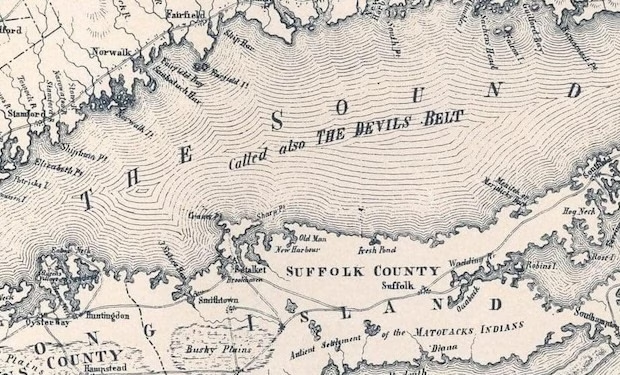Long Island Sound, the serene estuary nestled between Long Island and the Connecticut shoreline, wasn’t always considered a safe haven for sailors. In fact, during colonial times, its dangerous waters and hidden hazards earned it the sinister nickname “The Devil’s Belt.”
This ominous title wasn’t just a flight of fancy—it reflected the perilous experiences of mariners who dared to navigate its unpredictable currents, rocky shoals, and hidden reefs. Among the most feared spots was the narrow waterway linking the East River to the Sound, known as Hell Gate. Even today, Hell Gate is infamous for its strong tidal currents and whirlpools, though modern engineering has made it less threatening than in centuries past.
Adriaen Block and the First Maps of the Sound
The first European to explore and map Long Island Sound was Dutch navigator Adriaen Block in 1614. Sailing eastward from the East River, Block documented the waters and islands of the region, including the landmass we now call Long Island. This exploration marked the beginning of European recognition of the Sound’s strategic and economic importance.
During the colonial era, maps often labeled this stretch of water as “The Devil’s Belt,” with treacherous reefs within the Sound ominously dubbed “The Devil’s Stepping Stones.” These names were a stark warning to mariners about the dangers lurking beneath the surface, where shipwrecks were not uncommon.
A Storied Past Preserved in Maps
Early cartographers included these eerie names on their maps, immortalizing the Sound’s fearsome reputation. The Devil’s Stepping Stones were said to be a series of jagged reefs and rocks that appeared almost deliberately placed to ensnare unwary sailors. Local legends even suggested supernatural origins for these hazards, adding to the mystique.
Today, while the Long Island Sound is better known for its picturesque harbors, thriving marine life, and recreational boating, its history as “The Devil’s Belt” is a reminder of the region’s treacherous maritime past. The transformation from feared waterway to beloved estuary highlights the evolving relationship between people and the sea.
Whether you’re sailing its waters or enjoying its shoreline, the Long Island Sound offers a window into the adventurous—and sometimes perilous—history of early navigation in the New World.
Photo: Map of Long Island, by William Fadden. 1 January 1779. Courtesy of Stony Brook University Libraries.




